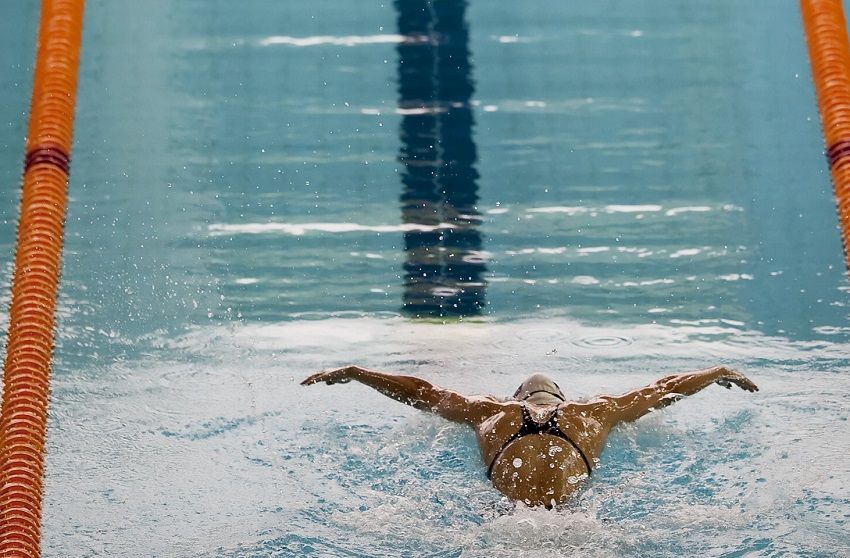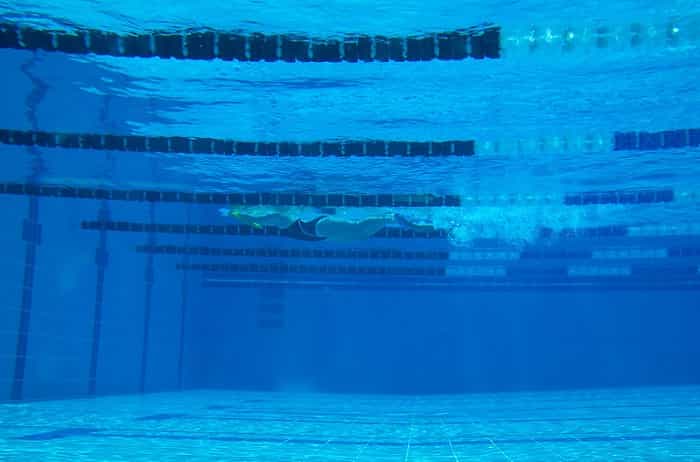
How to Use a Drag Chute for Faster Swimming
Looking for tips on how to use a drag chute for improved swim performances? Read on for some proven tips, sets, and pointers for training with a chute.

There are plenty of mental and physical health benefits to swimming laps.
But the thing that most people want to know when deciding on a form of exercise, is just how many calories will I burn from swimming?
The answer: probably a lot more than you think!
Of course, there are a TON of different variables.
Age, sex, weight, intensity levels, the stroke you choose, and more all play a role in how many calories you are burning in the pool.
But while we can’t say with exactness how much you will burn in your specific circumstance, we can hold up swimming against other forms of exercise and show you how it’s one of the all-time best ways of shredding calories like they owe you money.
Here is a breakdown of how many calories you can expect to blowtorch while swimming.
Researchers at Harvard broke down how many calories are burned in a wide variety of activities over a 30-minute span. They looked at just about every activity you can think of, including things that aren’t really “activities” in the physical sense: Sleeping, watching television, and so on.
They looked at caloric burn for individuals at 125, 155, and 185-pounds. (The chart below shows a comparison of how many calories are burned for a 185-pound person).
Doing swim workouts for weight loss and calorie burning performed exceptionally well, out-burning a lot of traditional sports and activities like cross-country skiing, playing football, sparring in the boxing ring. In fact, the only things that burned more calories than swimming was running at an 8-mile pace or faster and bicycling at 16 mph or faster.
See also: Swimming vs Running: Which One is Better for You?
Per 30-minutes of exercise for a 185-pound person:
Below is how swimming front crawl stacks up against a few other popular activities, including my all-time favorite (hint: it rhymes with “sleep”):
This is always the second question when the topic of calorie burning in the pool comes up: What is the best swimming stroke for weight loss?
According to the same study, freestyle (front crawl) AND butterfly led the pack, with our 185-pound example person burning 488 calories per 30 minutes of swimming. Freestyle is the most commonly performed stroke performed in the pool.
Butterfly, is not.
Even novice and expert swimmers struggle to maintain efficient form and technique for extended periods of time.
The next best swim strokes for weight loss vary according to who you talk to.
Harvard puts swimming breaststroke at third place in the calorie melt-off contest, burning 444 calories per half-hour of swimming. Fourth goes to backstroke at just 355 calories. British Swimming, meanwhile, has breaststroke in last place for calorie burning and backstroke in third place.
Ultimately, the “best” swim strokes for weight loss come down to what you are proficient at in the water.
If it works for you in the water and you enjoy it, you are more likely to continue doing it in the long run, which will vastly out-perform any short-term gains you get from trying to swim 30-minutes straight of butterfly (or rather, “butter-die”).
Here’s a look at how the different swimming strokes perform when it comes to shredding calories:
Beyond a lot of the obvious health benefits of swimming, there are some additional sneaky reasons you should take up swimming to choke-slam calories.
A few of my favorites include:
Working out, whether in the gym or running on the trail, provides a measure of instant feedback with a red face and a sweaty shirt, signaling a good effort.
Swimming, because it is usually done in a cool pool that hides how warm you are working, is a sneaky-sneaky way to torch calories.
Even though you might not notice the sweat that is dripping off your brow while you swim (yes, you do sweat while you swim so make sure you are hydrating in the same manner you would with any other form of physical exercise), you are getting the physical benefits of churning up and down the pool.
The low-impact nature of the activity means you can usually exercise for longer.
Research with sedentary adults found this was exactly the case, as they were able to spend more time exercising in the water versus higher impact activities that left joints, ligaments, and muscles feeling sore.
This means you can combine the high rate of caloric burn with an extended duration of exercise for a killer 1-2 calorie knockout.
Yup, you will notice your shoulders getting wider and more defined at the same time as your waistline is shrinking.
Double whammy. Cool.
But wait… it gets better.
Unlike most land-based aerobic activities, which are almost all entirely lower body dominated —running, cycling, spin classes, walking, skipping rope—swimming exercises provide a more well-rounded approach to exercise and calorie burning.
(Oh, and the whole breath management aspect of swimming also means your pulmonary system is getting a serious workout. Better than running.)

Okay, okay, so swimming for weight loss and calorie smashing is right in your wheelhouse.
Got it.
But not so fast.
Before you rip down to the pool to get your Phelps on, here are some helpful pointers for making sure that you continue to burn calories from swimming long after those first few weeks.
HIIT isn’t just for land-based activities. You can incorporate the fat and calorie blasting effects of high-intensity interval training without having to open yourself to increased load or joint load.
Break up your long, slower swims with high-speed efforts.
Interval training is a proven and power-packed way to get a killer workout in a fraction of the time and burn calories like crazy.
Like any sport or activity, swimming is not without its trademark injuries. Swimmer’s shoulder and breaststroker’s knee are two of the more common ones that occur as a result of overuse, muscle imbalances, and poor technique.
Feel free to mix things up when you get in the water to keep things fresh and reduce overloading the same muscles over and over again.
Not only can you do different strokes, but you can also incorporate kicking on a board to target your legs and/or pulling with a pull buoy to emphasize your upper body.
Your body is a wonderful, magical, and unbelievably ADAPTABLE piece of machinery. If calorie burn and weight loss is your goal, regularly turning up the intensity and challenge of your workouts is critical to keep your metabolic engine cooking.
If this week you are doing 1,500 meters in half an hour, try and do 1,600 meters next week in the time frame. If you did 8x50s freestyle fast this week and averaged :35 seconds per rep, try and hit :34 next week.
This kind of progression and steady and incremental increase of intensity and volume will not only keep the calories running for cover, but you will be wildly and relentlessly motivated seeing how much better and faster you are getting week over week.
Track your swim workouts and progression in your logbook and watch the calories melt and the motivation skyrocket.
9 Health Benefits of Lap Swimming. Getting in the pool is more than just smashing calories–there are plenty of other awesome health benefits to exercising in the water.
3 Swimming Workouts for Supercharged Weight Loss. Looking for some swimming workouts to lose weight? Try these 3 swim workouts that are designed to torch fat and help you get fit.

Olivier Poirier-Leroy Olivier Poirier-Leroy is the founder of YourSwimLog.com. He is an author, former national level swimmer, two-time Olympic Trials qualifier, and swim coach.
✅ Free shipping on Orders over $49
✅ Price Match Guarantee
✅ Best selection of gear for training and competition
✅ Fast and Easy Returns

“This is the best book I have ever seen concerning mental training.” — Ray Benecki, Head Coach, The FISH Swim Team


Looking for tips on how to use a drag chute for improved swim performances? Read on for some proven tips, sets, and pointers for training with a chute.

Ready to take your swimming to the next level? Here are seven ways that a drag chute can help you become a better and faster swimmer.

Wondering if a swim bench can help improve your swimming? Here are six benefits of swim benches for better technique, more power, and faster swimming.

Not breathing into the walls is one of the fundamental skills developing swimmers are taught. Here is how powerful a no-breath approach is for turn and swim speed. Strong training habits are something swimmers hear a lot about from their earliest days of their competitive swimming careers. The greatest hits

Drills with a swim snorkel are one of the best ways to maximize engagement and skill development. Here are five swim snorkel drills to try for faster swimming.

Looking to add some flavor to your kick sets and workouts? Here are some kickboard drills swimmers can use for faster swimming.
SITE
SHOP
GUIDES

LANE 6 PUBLISHING LLC © 2012-2025
Join 33,000+ swimmers and swim coaches learning what it takes to swim faster.
Technique tips, training research, mental training skills, and lessons and advice from the best swimmers and coaches on the planet.
No Spam, Ever. Unsubscribe anytime.
